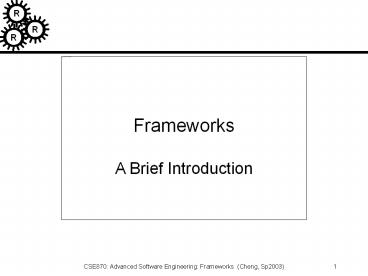Frameworks PowerPoint PPT Presentation
Title: Frameworks
1
Frameworks
- A Brief Introduction
2
Assigned Reading
- Designing Reusable Classes Johnson and Foote
(JOOP88) - Original Frameworks paper
- Gives guidelines for creating frameworks
- Motivates frameworks
- See Handouts and Links web page
3
Framework
- Support reuse of detailed designs
- An integrated set of components
- Collaborate to provide reusable architecture for
- Family of related applications
4
Frameworks
- Frameworks are semi-complete applications
- Complete applications are developed by inheriting
from, and - Instantiating parameterized framework components
- Frameworks provide domain-specific functionality
- Ex. business, telecommunication, dbases,
distributed, OS kernels - Frameworks exhibit inversion of control at
run-time - Framework determines which objects and methods to
invoke in response to events
5
Class Libraries vs Frameworks vs Patterns
- Application
- Specific
- Logic
Networking
- Definition
- Class Libraries
- Self-contained,
- Pluggable ADTs
- Frameworks
- Reusable, semi-complete applications
- Patterns
- Problem, solution, context
ADTs
Invokes
Math
Event Loop
Dbase
UI
Class Library Architecture
Math
Networking
UI
Application Specific Logic
Invokes
Call Backs
ADTs
Event Loop
Dbase
Framework Architecture
6
Component Integration in Frameworks
- Framework components are loosely coupled via
callbacks - Callbacks allow independently developed software
to be connected together - Callbacks provide a connection-point
- Generic framework objects communicate with
application objects - Framework provides common template methods
- Application provides the variant hook methods
7
Patterns vs Frameworks
- Patterns and frameworks play complementary,
cooperative roles - Patterns are more abstract descriptions of
frameworks - Frameworks are implemented in specific language
- Complex frameworks may involve dozens of patterns
- Patterns may document frameworks
8
GUI Framework
- Model/View/Controller (MVC)
- Smalltalk-80 UI framework
- UI 3 types of components
- models, views, controllers
- view and controller objects interacting with
model - Model application object, UI-independent
- View manages region of display
- Keeps it consistent with state of model
- Can be nested to form complex UIs
- Controller converts user events (e.g., mouse
movements and key presses) into operations on its
model and view - Implement scrolling and menus
9
Example MVC
- Model FileBrowser
- Views
- Top subview String that is Pattern that matches
set of files (e.g., .h) - Middle subview displays list of files that match
pattern (e.g., Node.h, Int_node.h, etc.) - Bottom Subview displays selected file
- TextView (Top and Bottom subviews)
- SelectionInListView (Middle subview)
- Controller
- Controller for each view
- Mouse move from subview, activating different
views
10
Variations of MVC Framework
- MacApp (Macintosh applications)
- Andrew Toolkit (CMU 88)
- InterViews (Stanford 89)
- Commercial
- zApp (OS-independent)
- OpenStep (part of much bigger, comprehensive
system) - Microsoft Foundation Classes
11
Key Principles
- How to develop successful patterns and frameworks
- Separate interface from implementation
- Determine what is
- Common interface and (common -gt stable)
- Variable implementation
- Allow substitutions for variable implementations
via a common interface - Dividing commonality from variability should be
goal-oriented rather than exhaustive
12
Open/Closed Principle
- Determining common vs variable components is
important - Insufficient variation makes it hard for users
to customize framework components - Insufficient commonality makes it hard for users
to understand and depend upon frameworks
behavior - Generally, dependency should always be in the
direction of stability - Component should not depend on any component less
stable than itself - Open/Closed Principle
- Allows most stable components to be extensible
13
Open/Closed Principle
- Components should be
- Open for extension
- Closed for modification
- Implications
- Abstraction is good
- Inheritance and polymorphism are good
- Public data members and global data are bad
- Run-time type identification can be bad
14
Violating Open/Closed Principle
- Struct Shape / . . . /
- Class Square public Shape / . . . /
- Class Circle public Shape / . . . /
- void draw_square const Square )
- void draw_circle const Circle )
- void draw_shape (const Shape shape)
- switch (shape.shapeType)
- case SQUARE
- draw Square ((const Square ) shape)
- break
- case CIRCLE
- draw Circle ((const Square ) shape)
- break
- // etc.
15
Applying Open/Closed Principle
- class Shape
- public
- virtual void draw () const 0
- void draw all (const Shape shape)
- shape.draw ()
16
Observations of Frameworks
- Benefits of frameworks
- Enable direct reuse of code
- Enable larger amounts of reuse than standalone
functions or individual classes - Drawbacks
- High initial learning curve
- Many classes, many levels of abstraction
- Flow of control for reactive dispatching is
non-intuitive - Verification/validation of generic components is
hard

